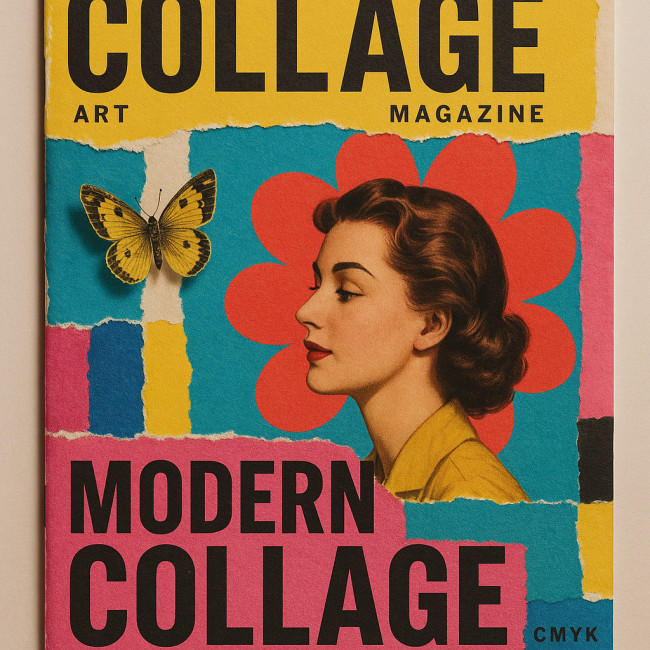Licensing collage artwork for magazines: usage tiers, renewals and global rights
Licensing collage artwork can feel like walking through a maze of legal terms, geographic splits and ever-changing print runs. In this guide, you will learn how magazine publishers classify usage, the clauses that protect your income during renewals and the traps to avoid when a client requests global rights.
Why magazines license collage artwork

Editors crave visuals that spark curiosity and convey layered meaning in a single glance. Collage delivers exactly that, making it a go-to choice for cover art, section openers and advertorials. By licensing rather than commissioning outright, publishers get speed and budgeting flexibility, while you, the artist, retain intellectual property and open doors to future income—much like selling a surface pattern bank.
Decoding usage tiers
Most magazine contracts bundle rights into three practical tiers. Knowing how each tier works lets you quote confidently and sidestep scope creep.
Tier 1 – Single edition, single territory
- Print and digital edition of one issue only.
- Restricted to one country or language region.
- Typical fee range: 300 – 600 € per full-page illustration.
Tier 2 – Multi-issue or multi-territory
- Up to four issues within 12 months OR simultaneous editions in several regions.
- Online archives for the same period.
- Typical fee range: 600 – 1 200 € per full page.
Tier 3 – Global & perpetual
- Unlimited issues, all territories, no end date.
- Includes marketing use across social, POS and partner newsletters.
- Typical fee range: 2 000 € + and often negotiated as a buy-out.
Quick-view comparison
| Factor | Tier 1 | Tier 2 | Tier 3 |
|---|---|---|---|
| Print run | Single issue | Up to 4 issues | Unlimited |
| Territory | Local | Regional/Language groups | Worldwide |
| Typical fee | €300–600 | €600–1 200 | €2 000+ |
| Renewal option | Yes, after 3 months | Yes, after 12 months | Not applicable |
Pricing levers that boost your fee
The fee ranges above are benchmarks. You can nudge numbers upward by highlighting:
- Circulation size – a 30 k print run should not cost the same as one hitting 300 k.
- Placement – covers command 20–40 % premiums.
- Exclusivity window – a longer embargo on re-licensing elsewhere merits a higher rate.
- Artist reputation – proven sales or awards justify top-tier pricing.
- Use beyond editorial – ads, tote bags or events move the deal closer to a merchandise licence, similar to object-design royalty models.
Renewal cycles: keep income flowing
Editors frequently republish evergreen stories in annual “best of” issues or special supplements. Your contract should therefore:
- Define an alert clause: the publisher must notify you 30 days before any reuse.
- State the renewal fee: industry norm is 50–75 % of the original price for identical scope.
- Cap the number of renewals: three cycles maintain fairness and encourage fresh commissions.
Tracking is easier when your artwork lives in a directory page that logs publisher requests in one place—like this example profile on collage licensing specialist Martin Lesguillons.
Global rights: agree without giving away the farm
Sometimes a client insists on worldwide, perpetual usage. If you grant it, bake compensation and safeguards into the contract:
- Revenue share on derivative products – 5–10 % of net sales when the collage appears on spin-off books or branded merchandise.
- Credit line requirement – ensure your name and website stay visible wherever the image appears.
- Reversion clause – if the publisher folds or is acquired, rights revert back to you after a set period.
- Audit rights – the right to review sales statements annually mirrors protections used in food-media licensing deals.
Workflow checklist for a friction-free license
- Confirm tier, fee and credit line in writing before supplying high-resolution files.
- Deliver layered PSD or TIFF only after receiving the countersigned agreement.
- Embed metadata: your name, copyright notice, licence end date.
- File naming: Magazine_Issue_Date_Artist_Title_LicenceEndYYYYMMDD.tif.
- Store all paperwork in a single cloud folder—practice borrowed from mosaic print licensors.
Mini-quiz: Are you licence-ready?
FAQ
- Can I licence the same collage to multiple magazines?
- Yes, unless you have signed an exclusivity clause. Always check that the embargo period has lapsed before relicensing.
- How do I calculate fees for cover wrap-arounds?
- Multiply your full-page rate by 1.5 – 2 depending on the circulation and ad value of the cover.
- What if a publisher reuses my art without notifying me?
- Send a formal invoice referencing the unauthorised reuse, backed by your contract's alert and penalty clauses. Most publishers settle quickly to avoid legal action.
- Do I need model releases for portrait fragments in collage?
- If recognisable faces appear, yes. Use royalty-free stock or obtain releases to avoid infringement claims.
Key takeaways
- Match scope to tier: single edition, multi-territory or global.
- Renewal clauses keep long-tail revenue alive.
- Global rights demand premium fees and protective language.
- Clear workflow and metadata avert future disputes.
Ready to secure your next magazine deal? Draft your licence using the tips above and turn collage passion into predictable income.











